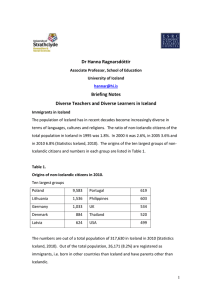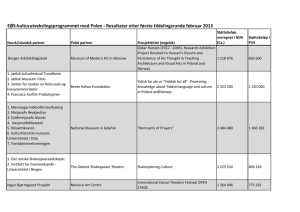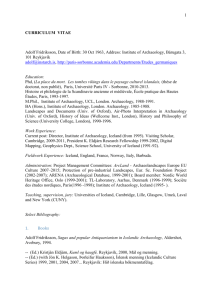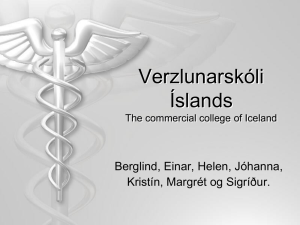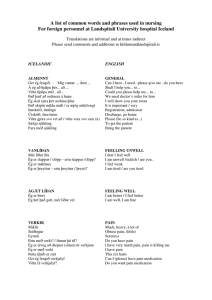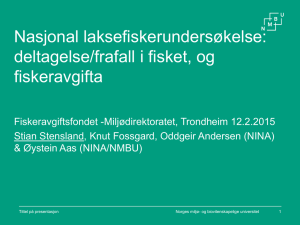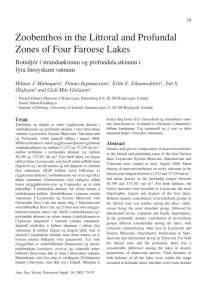Introduction
advertisement
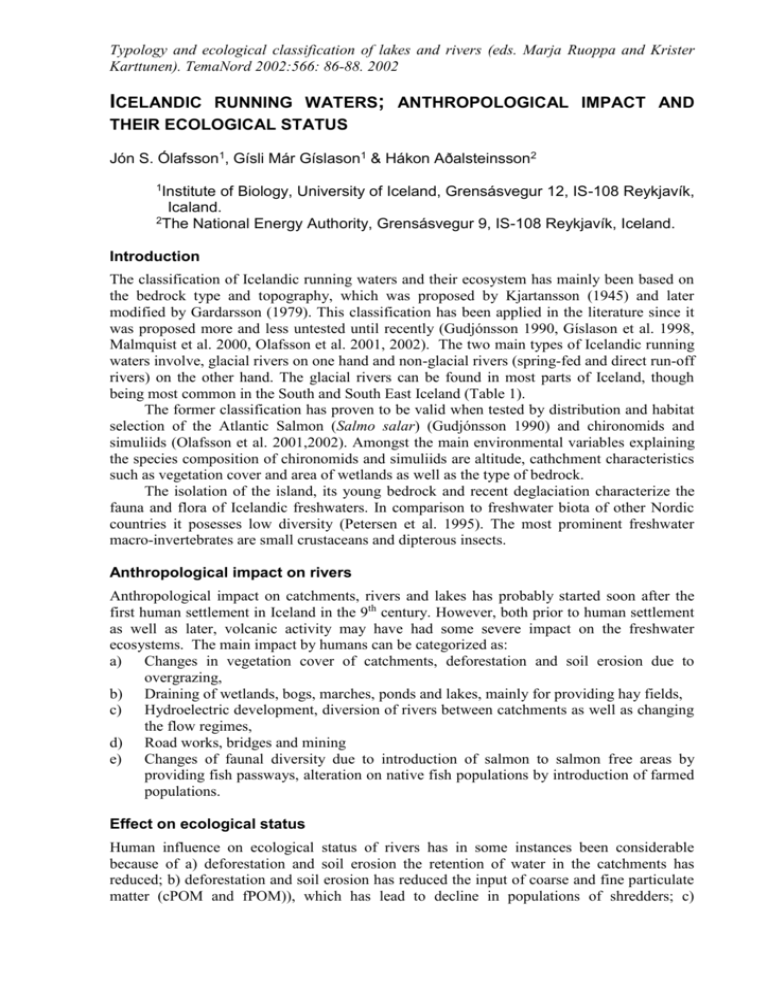
Typology and ecological classification of lakes and rivers (eds. Marja Ruoppa and Krister Karttunen). TemaNord 2002:566: 86-88. 2002 ICELANDIC RUNNING WATERS; ANTHROPOLOGICAL IMPACT AND THEIR ECOLOGICAL STATUS Jón S. Ólafsson1, Gísli Már Gíslason1 & Hákon Aðalsteinsson2 1Institute of Biology, University of Iceland, Grensásvegur 12, IS-108 Reykjavík, Icaland. 2The National Energy Authority, Grensásvegur 9, IS-108 Reykjavík, Iceland. Introduction The classification of Icelandic running waters and their ecosystem has mainly been based on the bedrock type and topography, which was proposed by Kjartansson (1945) and later modified by Gardarsson (1979). This classification has been applied in the literature since it was proposed more and less untested until recently (Gudjónsson 1990, Gíslason et al. 1998, Malmquist et al. 2000, Olafsson et al. 2001, 2002). The two main types of Icelandic running waters involve, glacial rivers on one hand and non-glacial rivers (spring-fed and direct run-off rivers) on the other hand. The glacial rivers can be found in most parts of Iceland, though being most common in the South and South East Iceland (Table 1). The former classification has proven to be valid when tested by distribution and habitat selection of the Atlantic Salmon (Salmo salar) (Gudjónsson 1990) and chironomids and simuliids (Olafsson et al. 2001,2002). Amongst the main environmental variables explaining the species composition of chironomids and simuliids are altitude, cathchment characteristics such as vegetation cover and area of wetlands as well as the type of bedrock. The isolation of the island, its young bedrock and recent deglaciation characterize the fauna and flora of Icelandic freshwaters. In comparison to freshwater biota of other Nordic countries it posesses low diversity (Petersen et al. 1995). The most prominent freshwater macro-invertebrates are small crustaceans and dipterous insects. Anthropological impact on rivers Anthropological impact on catchments, rivers and lakes has probably started soon after the first human settlement in Iceland in the 9th century. However, both prior to human settlement as well as later, volcanic activity may have had some severe impact on the freshwater ecosystems. The main impact by humans can be categorized as: a) Changes in vegetation cover of catchments, deforestation and soil erosion due to overgrazing, b) Draining of wetlands, bogs, marches, ponds and lakes, mainly for providing hay fields, c) Hydroelectric development, diversion of rivers between catchments as well as changing the flow regimes, d) Road works, bridges and mining e) Changes of faunal diversity due to introduction of salmon to salmon free areas by providing fish passways, alteration on native fish populations by introduction of farmed populations. Effect on ecological status Human influence on ecological status of rivers has in some instances been considerable because of a) deforestation and soil erosion the retention of water in the catchments has reduced; b) deforestation and soil erosion has reduced the input of coarse and fine particulate matter (cPOM and fPOM)), which has lead to decline in populations of shredders; c) Typology and ecological classification of lakes and rivers (eds. Marja Ruoppa and Krister Karttunen). TemaNord 2002:566: 86-88. 2002 reduction of nutrient input into the rivers and less productivity caused by less cover of soil in the catchments; d) changes in flow regimes due to draining of lowland wetlands, mainly reduced the retention time of the water in the catchments; e) less silt in glacial rivers that have been dammed near their headwaters to make storage reservoirs, which can lead to increased invertebrate diversity in the rivers; f) increased disturbance on animal life in rivers that are used for gravel mining or in the vicinity of newly build bridges and roads; g) increased mixing of farmed and native fish population is a threat that has gained an increased attention recently, however, little data is available on the topic. Human impacts on rivers in Iceland are considerable and has undoubtedly reduced the species diversity and decreased the productivity of river ecosystems. GLACIER FED RIVERS NON GLACIER FED RIVERS Glacier melt water. Great annual and diurnal fluctuations in discharge and temperature, usually low in pH (6-8) and conductivity (10-80μS/cm). Low biodiversity. S, SE, E and NE Iceland. Precipitation and springs. SPRING FED RIVERS DIRECT RUN-OFF RIVERS Sub terrain springs in neo-volcanic areas on permeable palagonite bedrock formations. Stable discharge and temperature, high pH (7.0-10.0) and conductivity (80-200 μS/cm). High biodiversity. SW, S and NE Iceland. Mainly surface water, on impermeable tertiary basalt bedrock. Great annual fluctuations in discharge and temperature, relatively low pH (7.0-7.5) and conductivity (20-120 μS/cm). (1) SPRING FED RIVERS (1) RUN-OFF RIVERS With lake influence, high in fPOM and moderate biodiversity. Mainly short rivers with little influence from lakes or wetlands. Great fluctuations in discharge and temperature, with low conductivity (10-70 μS/cm). NV, N and E Iceland. (2) SPRING FED RIVERS (2) RUN-OFF RIVERS Without lake influence (hot and cold) usually lower in fPOM than no. 1 (above) but moderate biodiversity. Mainly , buffered with deep valley lakes. Considerable fluctuations discharge and temperature, Conductivity: 60-70μS/cm. Fairly low biodiversity. W Iceland. (3) RUN-OFF RIVERS Originated from well vegetated wetland plateau (moor). Buffered by wetlands (ponds and lakes), medium fluctuations in discharge and temperature, reduced by wetland buffer effect, relatively high conductivity (50-120 μS/cm). Fairly high biodiversity. W, NW, NE and E Iceland. ________________________________________________________________ Table 1. The main types of running waters in Iceland; their characteristics and distribution (Based on Gardarsson 1979, Malmquist 1998, Adalsteinsson & Gíslason 1998, Olafsson 2001 and 2002). Typology and ecological classification of lakes and rivers (eds. Marja Ruoppa and Krister Karttunen). TemaNord 2002:566: 86-88. 2002 References Adalsteinsson, H & Gíslason, G. M. 1998. Áhrif landrænna þátta á líf í straumvötnum [Terrestrial influence on the biota in Icelandic rivers]. Náttúrufræðingurinn, 68:97-112. [in Icelandic, with an English summary]. Gardarsson, A. 1979: Vistfraedileg flokkun íslenskra vatna [An ecological classification on Icelandic freshwaters]. Týli 9:1-10. [in Icelandic, with an English summary]. Gíslason, G.M., Aðalsteinsson, H. & Ólafsson, J.S. 1998. Animal communities in Icelandic rivers in relation to catchment characteristics and water chemistry. Preliminary results. Nordic Hydrology. An International Journal 29(2): 129-148. Gudjónsson, S. 1990. Classification of Icelandic watersheds and rivers to explain life history strategies of Atlantic salmon. Unpubl. PhD thesis, Oregon State University, 136 pp. Kjartansson, G. 1945. Íslenzkar vatnsfallstegundir. Náttúrufræðingurinn, 15:113-126. [in Icelandic]. [Icelandic river types] Malmquist, H. 1998. Ár og vötn á Íslandi: Vistfræði og votlendistengsl [Rivers and lakes in Iceland: Ecology and wetland interactions]. In: Íslensk votlendi, verndun og nýting [Icelandic wetlands, conservation and utilization] (ed. J.S. Ólafsson). Háskólaútgáfan, Reykjavík, bls. 37-55. [in Icelandic, with an English summary]. Malmquist, H.J., Antonsson, T., Gudbergsson, G., Skúlason, S. & Snorrason, S.S. 2000: Biodiversity of macroinvertebrates on rocky substrate in the surf zone of Icelandic lakes. Verh. int. Verein. Limnol. 27: 121-127. Ólafsson, J.S., Adalsteinsson, H. & Gíslason, G.M. 2001. Classification of running waters in Iceland, based on catchment characteristics. Í: Classification of Ecological Status of Lakes and Rivers (eds. S. Bäck & K. Karttunen) TemaNord 2001: 584: 57-59. Ólafsson, J.S., Adalsteinsson H., Gíslason, G.M., Hansen, I. & Hrafnsdóttir, Th. 2002. Spatial heterogeneity in lotic chironomids and simuliids in relation to catchment characteristics in Iceland. Verh. Internat. Verein. Limnol. 28:157-163. Petersen, RC., Gíslason, G.M. & Vought, L. B.-M. 1995 . Rivers of the Nordic Countries. Chapter 10. Pp 295-341 In: (eds C.E. Cushing, K.W. Cummins & G.W. Minshall.) Ecosystems of the World, Vol. 22. River and Stream Ecosystems. Elsevier Press, Amsterdam .
